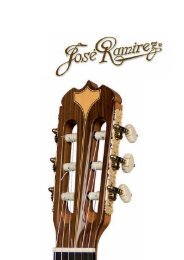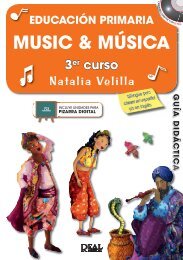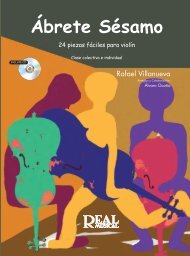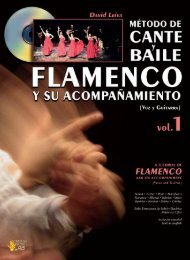Create successful ePaper yourself
Turn your PDF publications into a flip-book with our unique Google optimized e-Paper software.
STUDY TIPS 2<br />
15. Practice 1 hour of technical exercises daily or dedicate one day of the week exclusively to<br />
technique.<br />
16. In order to achieve an optimally clean sound in our playing, we should be as strict as possible<br />
with ourselves. When we notice a mistake in our playing, however small, it is better to stop and<br />
fix the problem. Playing duffed or unclear notes is akin to speaking without vocalising, and we<br />
should remember this simile in order to improve our guitar playing.<br />
17. To improve picado technique, play speed bursts of 2, 3, 4 or 5 notes as fast as possible. This will<br />
develop more muscle in the right hand and increase our picado speed over a short period of time.<br />
18. To continue educating our musical ear, improving as musicians, and widening our repertoire, we<br />
should transcribe musical phrases by ear while listening to CD tracks of the great guitar masters.<br />
This will help us to play in time and we will learn to listen to flamenco in more detail.<br />
19. We can improve our sight reading by playing musical variations and pieces. The main factors that<br />
will aid our reading are looking ahead on the score, keeping the body relaxed, and playing the<br />
piece at a slow pace. At first it is better to read scores which we have played before, looking a few<br />
measures ahead while playing. This reduces the surprise element of the piece or phrase. The<br />
more we practice sight reading, the better. Before playing it is advisable to read the score without<br />
the guitar to make a general analysis.<br />
20. Work on the memory to retain musical phrases and pieces. This section is divided into two parts:<br />
“Visual memory” and “Retentive memory”.<br />
a) Visual memory is what we use when playing from a musical score that we know how to play.<br />
As we play we remember fingerings, melodies, chords, phrases, etc. However, the<br />
peculiarity of this type of memory is that without the score, we can hardly play a note. This<br />
memory is developed simply by playing different scores because it is on a subconscious and<br />
automatic level.<br />
b) Retentive memory is what we use when we play without needing a score. The most effective<br />
way to develop this memory and achieve results almost immediately, is to play repeatedly<br />
through measures or phrases. When working on a new piece or phrase we should firstly<br />
read the score thoroughly without playing, while observing how many phrases or variations<br />
there are. Next we imagine the positions of the left hand on the fingerboard. The following<br />
step is to take the instrument and slowly play through each phrase to learn the fingerings<br />
and phrasing in detail. The final step is to repeat the measures over and over again and<br />
then to do the same with the phrases.<br />
9






